#yellow wintersweet
Text
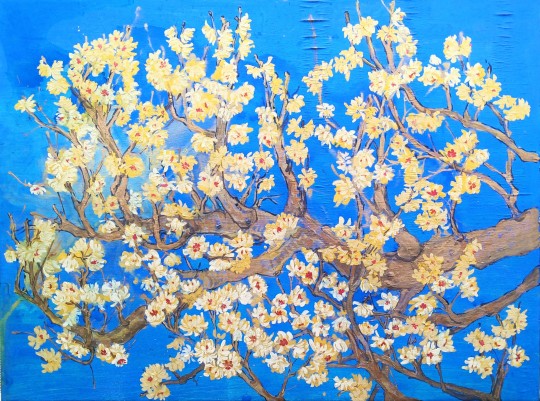
Sweet and Spice
Watercolor On Birch Panel
2022, 40"x 30"
Japanese Allspice, Wintersweet, Chimonanthus praecox
#art#nature#artists on tumblr#flowers#floral#watercolor#painting#minimalism#artwork#botany#japanese allspice#wintersweet#gold#yellow#blue#chimonaanthus#trees#flowering tree#botanical#artblr#spring#naturecore#cottagecore aesthetic#contemporary art#original art#artist#creatrs#cottagecore
411 notes
·
View notes
Text

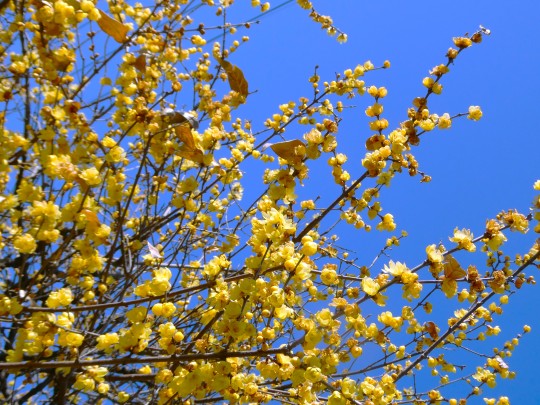



Wintersweet (Chimonanthus praecox)
145 notes
·
View notes
Photo
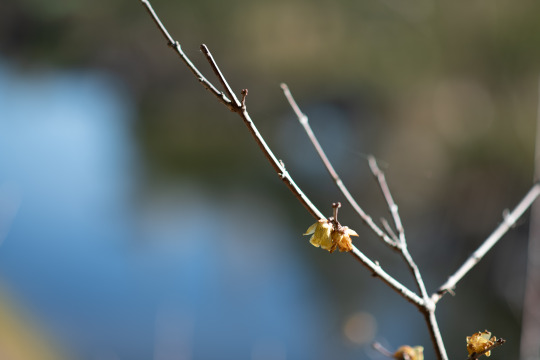
20240127 Atsuta ward 6 by BONGURI
多分終わりがけのソシンロウバイ。 @Shirotori garden, Atsuta ward, Nagoya city, Aichi pref.(愛知県名古屋市熱田区 白鳥庭園)
#flower#yellow#yellowflower#wintersweet#japaneseallspice#smallflower#petal#nature#shirotorigarden#garden#japanesegarden#atsutaward#atsuta#nagoya#aichi#japan#nikon#afsnikkor85mmf18g
2 notes
·
View notes
Text
Hey, remember that time I wrote a 28K word fic based a single manga panel of canonically deceased Tsuguko?
TODAY'S MY OC'S BIRTHDAY

Happy birthday, Kobayashi-san! OC lore below~
Kobayashi's birthday is January 2, and she's named Suzuno for the sound of shrine bells being rung with good wishes for the New Year. ^_^
That's not new lore if you have happen to be among the few dozen people or so who enjoyed all the OC Tsuguko lore, but something to highlight more is Kobayashi's theme flower, the robai! I've heard them called anything from wintersweet to wax flower, but basically they are a cousin of plum blossoms that come in a translucent yellow, with very fragrant blossoms from about December to February. I love these flowers do I am decorating with some right now:
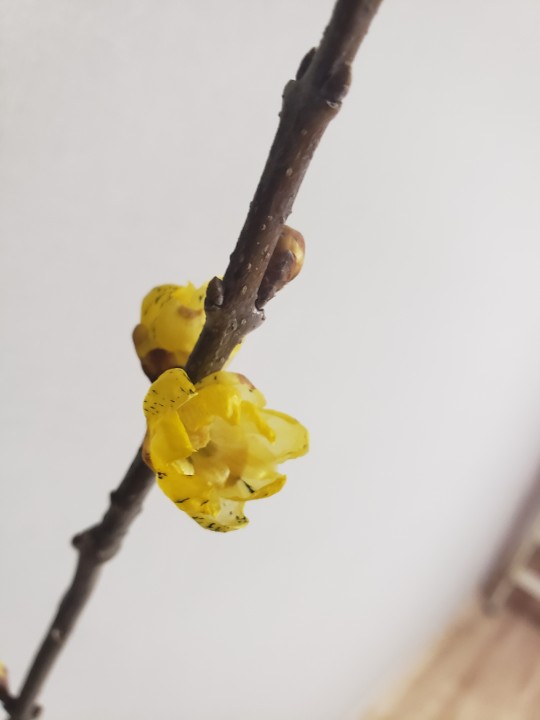
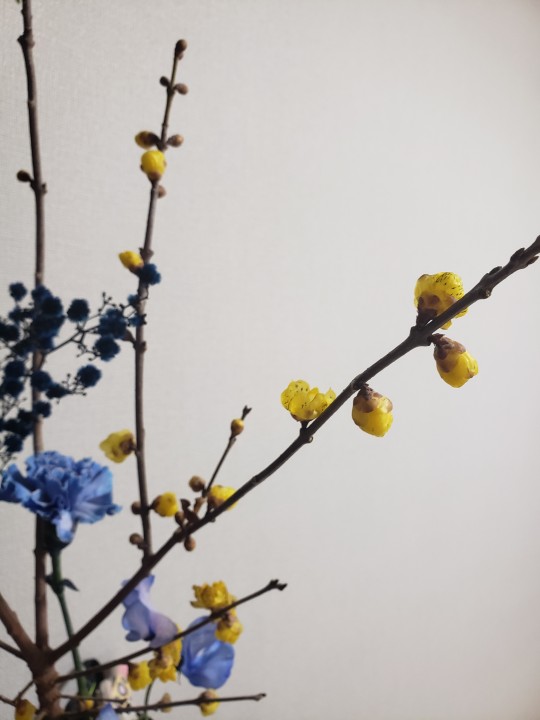
I like that they are both sweet and robust, so that's why I put a robai tree in the garden by the Tsugukos' room and wrote Kobayashi with a cheerful yellow butterfly hairpiece.
I wound up associating Ichijo (the Tsuguko who was dead before the fic started) with rugosa rose in a post-fic Ask, but have not been hit with the right inspiration for a flower to association with Mita. Probably something prickly. XD
101 notes
·
View notes
Text

Title:Wintersweet
Wintersweet in yellow,
The flower of early spring
Has now bloomed fully
To show us a sign that
A bitter winter is moving gradually
To the phase of its next chapter...
蝋梅の花咲く。
春が待ち遠しい。
5 notes
·
View notes
Photo

Seven birthflowers ❀
Tiger Lily (orange) Sep 1 // JK
Wintersweet (yellow and dark red) Dec 30 // V
Bridal Wreath Spirea (white) Oct 13 // JM
Buttercup (yellow) Feb 18 // JH
Clematis (purple) Sep 12 // RM
Larch (round dark pink) Mar 9 // SG
Rumex (long red-pink) Dec 4 // JN
#bts fanart#birth flowers#bangtan#flower#watercolor#watercolours#Illustration#painting#traditional art#nature#artists on tumblr#namjoon#seokjin#yoongi#hoseok#jimin#taehyung#jungkook
18 notes
·
View notes
Video
Asian Traditional Flower Art-Wintersweet Chimonanthus praecox (Yellow).
📧 [email protected]
#blossom #BlossomBeauty #artificialflowers #silkrose
#flowerphotography #flowers #importflower #exportflower #artificialflowermanufacturer #flowerfactory #driedflower #peonyflower #lotus #wintersweet
0 notes
Text
Flowering hedges: 12 Best hardy hedge plants with flowers
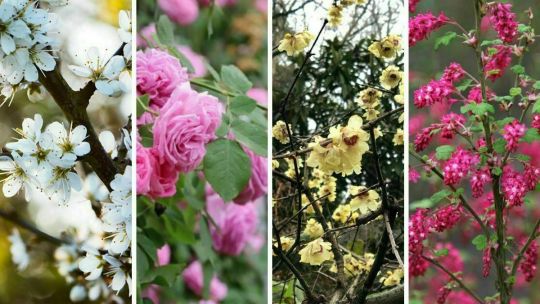
When you think of hedges, you often have the image of accurately pruned, green hedge plants in your mind. No wonder, after all, classics such as the tree of life (Thuja) or false cypress (Chamaecyparis lawsoniana) are still among the most popular hedges today. But if you don't like the evergreen hedges, you don't have to do without the privacy screen: Flowering hedges are a great eye-catcher in the garden.
Especially their changeability, with which they present themselves anew from season to season, offers the variety that many gardeners miss with evergreen hedges. Besides, flowering hedges are also an enrichment for the variety of species in the garden.
For example, the flowers often attract numerous beneficial insects, while birds like to use the hedges as a place of retreat. We have compiled our twelve favorite winter-hardy hedge plants with flowers in this list for you.
1. Common Ninebark
If you don't feel like going through boring green hedges, you should definitely take a look at the common ninebark (Physocarpus opulifolius). For example, the Bladder Spawners 'Diabolo' with its blood-red leaves, which look almost black in sunlight, is eye-catching.
Especially from May to June, the flowering hedge forms a dramatic climax when the cream-white flowers open. The red-leaved 'Diable d'Or' or the yellow-leaved variety 'Dart's Gold' also impress with their flowers and foliage coloring.
The Bladder Pier is also particularly popular because of its absolutely easy-care nature: the flowering hedge is not only one of the best hardy hedge plants but also very robust and, with a height of up to 6.5 feet, forms a reliable screen in summer.
2. Red Flowering Currant
Thanks to its robust nature, the Blood Currant, (the flowering currant, redflower currant, or red-flowering currant) is particularly suitable for a free-flowering hedge. This means that the plant requires hardly any care except for regular watering. Besides, the Blood Currant is particularly hardy as a flowering hedge.
Thanks to its dense branching and a growth height of up to 6.5 feet, the plant is also suitable as a privacy screen. The pretty red flowers of the plant appear from April to May and are a magical attraction not only for the eyes but also for insects.
As an ornamental form, the blood-red currant only grows sparsely edible fruits, which have a rather sour taste and are therefore rather unpopular with humans. On the other hand, birds are happy about the berries and like to use the hedge as a source of food.
3. Box-Leaved Barberry
It is probably one of the most famous flowering hedge plants: The box-leaved barberry, Dwarf Magellan Barberry (Berberis buxifolia 'Nana'), has become increasingly popular, especially recently, because it is considered a good and robust substitute for boxwood.
The barberry is particularly suitable for smaller hedges, as it is considered to be very hardy and tolerant of pruning. In May, when the evergreen, flowering hedge shows its golden yellow flowers, it even trumps the boxwood: the flowers are true insect magnets that attract beneficial insects of all kinds. The spherical, black-blue berries, on the other hand, are gladly eaten by birds.
4. Wintersweet
A flowering hedge in winter? Actually, this is not a dream, but rather the Chinese Winter Flowering - wintersweet (Chimonanthus praecox). Already in January - in milder winters even before Christmas - the blooming hedge plant shows its full splendor and opens its yellow star-shaped flowers.
You might also like this: Detecting iron deficiency in plants - and how to control it
The exotic plant is not only a ray of hope for people in winter: if mild temperatures attract beneficial insects from their quarters, they will find a welcome source of food in the wintersweet. With a height of up to 10 feet and sparse growth, the winter flower is particularly suitable for mixed flowering hedges.
However, it needs winter protection in the first few years. But as soon as the wintersweet Hedge has established itself as a flowering hedge, it can withstand temperatures down to 14° F without problems and is therefore considered one of the hardy hedge plants with flowers in most USA regions.
5. Lilac
With its intense scent, the lilac, common lilac (Syringa vulgaris) is a welcome guest in many gardens, and not only flatters the nose. As soon as the shrub shows its blue-violet flowers in May, the plant turns into a real feast for the eyes.
But not only are people enchanted by the lilac - the rich blossom, which lasts until June, also attract numerous bees and other beneficial insects that find a rich meal. If you are looking for an easy-care flowering hedge, the uncomplicated and hardy lilac is the right choice.
6. Mock Orange
A strong scent of jasmine and an impressive abundance of flowers - no wonder that the mock orange or English dogwood (Philadelphus coronarius) is also called false jasmine. Especially the intense scent of the white flowers, which appear from May to June, makes the flowering hedge a famous garden inhabitant.
You might like this: 5 Vegetarigan Summer recipes
Beneficial insects also love the common pipe shrub - it is not for nothing that it is one of the bee-friendly shrubs. As part of a flowering hedge for privacy protection, mock orange is well suited: in a relatively short time, it can reach impressive heights of up to 13 feet and looks particularly attractive with its slightly overhanging growth and the matt, deciduous leaves.
7. Beauty Bush
Between May and June, the Beauty Bush (Kolkwitzia amabilis) impresses with its light pink, slightly shimmering flower. The romantic glow of its pastel-colored flowers even gave the flowering hedge the pretty sobriquet "mother-of-pearl bush".
But the Beauty Bush is not only a treat for the eyes - when the hedge is in bloom, it exudes a pleasant smell in the garden, which also attracts numerous beneficial insects.
Thanks to its rapid growth, which can be around 12 inches a year, and its particularly robust nature, the flowering hedge is ideal in summer as a quick and easy-care visual protection. On the other hand, it is less suitable as a screen in winter because the flowering hedge is one of the hardy hedge shrubs but slowly loses its leaves in autumn, after a beautiful autumnal coloring.
8. Slender Deutzia
If one wants to talk about flowering hedges, one cannot pass the slender deutzia (Deutzia gracilis). Slender deutzia shrub has a luxuriant pile of star-shaped, small flowers from May to June. During this period, the white-flowering hedge fills the garden with a pleasant sweetish scent, which also attracts numerous bees. With a maximum height of 3.2 feet and its robust nature, the deciduous plant is particularly suitable for creating a small, flowering hedge.
You might also like this: 19 Plants that tolerate waterlogging
9. Rose
Roses (pink) are a must in the garden for many people. However, only a few people know that roses can also be wonderfully integrated as a privacy screen in the garden. Indeed, flowering hedges of wild roses, such as the potato rose (Rosa rugosa), or the sand rose (Rosa Mollis) is an excellent alternative to ordinary hedges.
The numerous flowers, whose flowering time can vary greatly depending on the variety, attract not only people but also numerous insects. In fact, wild roses are a good source of food for all kinds of beneficial insects - in contrast to the more common cultivated roses, which are often useless to insects because of their double flowers.
In late summer, the flowering hedge will additionally delight you with healthy rose hips, which are equally tasty for humans and many bird species.
10. Blackthorn
If you want not only a nice privacy screen but also a practical one, there is no getting around the blackthorn or sloe (Prunus spinosa) when choosing a hedge. Blackthorn, as the flowering hedge is also called, not only impresses from March to April with its numerous flowers but is also considered to be extremely insect-friendly. Besides, the white flowering hedge exudes a pleasant, sweetish smell.
From late autumn onwards, edible stone fruits appear on the blackthorn, which can be harvested after the first frost. People especially like liqueurs or jams made from the tart and aromatic fruits, birds, on the other hand, like to steal the berries directly from the tree.
The deciduous blackthorn is particularly popular in near-natural gardens, as it is not only important bee nourishment and bird protection shrub, but also offers a reliable privacy thanks to its height of up to 16.5 feet and dense growth.
11. Perennial Hibiscus
It is considered a real insider tip among the flowering hedge plants: The perennial hibiscus (Hibiscus moscheutos) impresses from July to October with its huge bell-shaped flowers. The white, pink, or red flowering hedge not only attracts people's attention, but it also attracts numerous insects.
Thanks to its bushy growth, the evergreen flowering hedge is perfect as a privacy screen for the balcony and garden. Unlike other hibiscus varieties, it is particularly one of the hardy hedge plants with flowers; an established perennial hibiscus can tolerate temperatures as low as -22° F. Only young plants need light weather protection in winter.
12. Weigela florida
Hardly any other flowering hedge plant is as popular as the Weigela florida or Variegata (Weigela florida). This indestructible, permanent flowering plant is considered particularly easy to care for. It is one of the few hedges that bloom almost all year round:
From the end of April, the white to pale pink colored flowers open and bloom tirelessly until June. But even in July and even until the first frost, there are always sporadic late blooms. With a height of up to 9.5 feet, the Weigela florida is wonderfully suited as a privacy screen - but the Weigelie must be pruned, preferably regularly; otherwise, it tends to grow old.
Read the full article
0 notes
Text

#yellow wintersweet#wintersweet#chinesische Winterblüte#botanical garden#botanical#botanic garden#sunny#January#winter#bees#green#plants#flowers
2 notes
·
View notes
Text

Sweet and Spice
Watercolor On Birch Panel
2022, 40"x 30"
Japanese Allspice, Wintersweet, Chimonanthus praecox
#art#nature#artists on tumblr#flowers#floral#watercolor#painting#minimalism#artwork#botany#japanese allspice#wintersweet#gold#yellow#blue#chimonaanthus#trees#flowering tree#botanical#artblr#spring#naturecore#cottagecore aesthetic#contemporary art#original art#artist#creatrs#cottagecore#plants
103 notes
·
View notes
Text
commissions chibi shading for ダイヤモンド
[COMMISSIONS]
chibi shading for ダイヤモンド
is he really cute? yeah he's so cute he even has snow on his head🥺❤️ winter is my favorite even though in my country there is no snow🙂
beautiful clothes beautiful hair and cute face and petite body, she is perfect!!
I'm happy when I draw there's no hassle because she's very cute🥺❤️ yes I learned something this time that her eye shading is very beautiful, and this time I will announce that this is the eye if you order shading at my place❤️
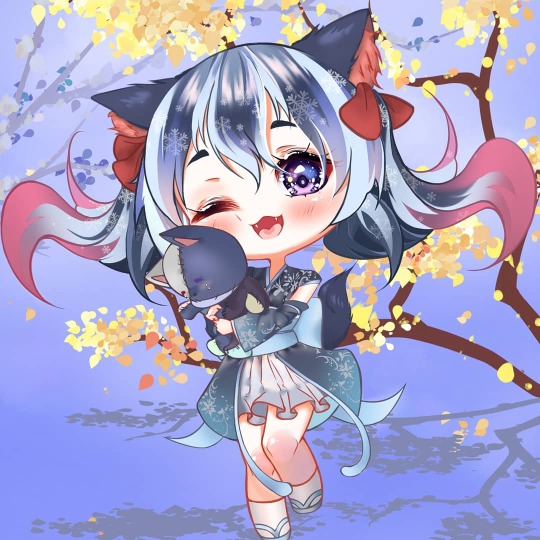
#anime#anime girl#anime art#drawing commisions#original art#clip studio paint#ibispaint art#neko girl#neko#cute cats#purple#yellow#purple eyes#yellow eyes#blue hair#blue eyes#blue clothes#winters#wintersweet#artwork#drawing#anime style#chibi girl#chibistyle#chibidrawing#chibi commission#chibianime#art#illustration
4 notes
·
View notes
Photo

春の兆し、蝋梅のいい匂い。 Signs of spring. Good smell of Japanese allspice. #signsofspring #springcomingsoon #japaneseallspice #wintersweet #yellow #flower #flowers #flowerstagram #plum #plumtree https://www.instagram.com/p/CYg8SvuvekD/?utm_medium=tumblr
#signsofspring#springcomingsoon#japaneseallspice#wintersweet#yellow#flower#flowers#flowerstagram#plum#plumtree
0 notes
Text
Flora and Fauna of Maglor’s Gap
More world building here!
Flora and fauna of Arda
requested by @meadowlarkx
Disclaimer: I used both what we can extrapolate is likely indigenous to the region based on descriptions of the landscape and climate as well as my own headcanons and inspirations and reference books on similar habitats as well as The Atlas of Middle Earth and The Flora of Middle Earth
I really love working on and researching these! and as always feel free to ask more, even if I’ve already done a place I’d always enjoy going into more detail of tacking a more specific kind of life there
Maglor’s Gap was a region of First Age Middle Earth between Himring and the Ered Luin. It was described as lowland country made up of thickets, shrubland and heavily forested areas. It was also mentioned to have a cooler climate due to its proximity to Himring and thus to Morgoth’s realms.
Based on descriptions of climate and habitat, possible shrubs and thicket species include sweet sagewort, rock wormwood, gorse, heather, hyssop, thyme, Hedera iberica, sumac, winter bent grass, orchard grass, boxthorn, and milkwort, and witch hazel.
The forested areas are likely comprised of smaller species of trees that can grow in cooler, drier environments. Single seeded hawthorn, smaller juniper trees, smaller trees and shrubs in the oak family, Chimonanthus salicifolius (a genus of wintersweet), smaller dogwoods and species of laurus that thrive in cooler climates.
There might also be grassier areas of perennial ryegrasses, scutch grass, fescue, and more.
Other plants include mountain cornflower, bearberry, species of aster, mouse eared hawkweed, spring savory, welted thistle, dyer’s woad, stellera, gooseberry, and fennel.
Possible birds are mainly terrestrial ones like the gray and rock partridge, bustard and bush quail, gray, black and painted francolin, snowcock, little bustard, merlin, ground jay, cheer pheasant, crested lark, and painted sandgrouse.
And possibly something like a small bush moa or scrubfowl.
The scrublands are not ideal for large, herd living grazing creatures but smaller or non herding ungulates are definitely a possibility such as a species of mouse-deer, musk deer or goitered gazelle.
Raccoon dogs are also well adapted to shrublands and may venture into the Gap as is the dhole and the Pallas cat.
Other mammals might include the gray marmot, ground squirrel, dormouse, field vole, alpine pika, woolly or mountain hares, long eared hedgehog, gray shrews, spotted civets, hog badger, and sable. (these are examples of species, there is likely a number of examples in the families of marmots, squirrels, rodents and rabbits, and shrews especially).
Reptiles and amphibians are rarer in the cooler climate but not nonexistent. Smooth skink, blindsnakes, Mcord’s box turtle, plateau brown frog, boreal digging frog, Siberian sand toad, and spiny newts are possible examples.
Insect and bug life is always hard to do concisely but grasshoppers and locusts, bees and wasps, and a variety of butterflies (veined scrub hopper, forest hopper, common windmill, swordtail, yellow tip, etc) are the most common representatives as are earthworms.
46 notes
·
View notes
Photo
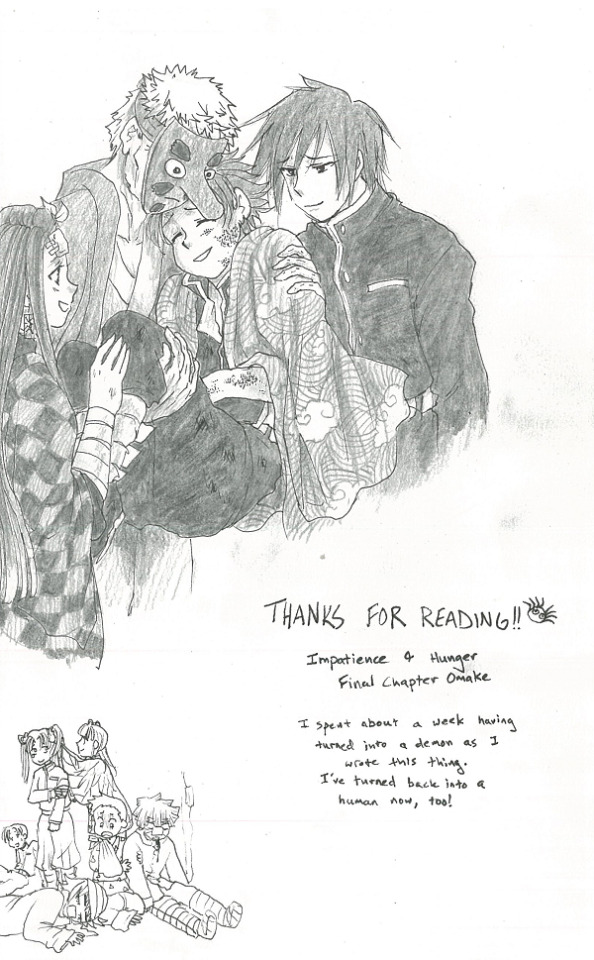
Omake for the final chapter of Impatience & Hunger, my Demon!Tanjiro and Slayer!Nezuko fic. For those who read it or checked it out, thank you!
And I totally have more omake. Actually, this is 1,500 words of extended epilogue I started adding, but I decided it was too detailed and sappy and that I wanted to the leave the last chapter as I had originally written it. But I drew this stuff to go with it, so the extra details of Tanjiro’s recovery go here, under the cut.


Tanjiro’s recovery over that winter hadn’t only been physical. Back on that day at the end of January when Inosuke came barging into Urokodaki’s home, he could sense something was unwell in Tanjiro’s heart, but it was a relief to Tanjiro that Inosuke didn’t have the words to address it. He couldn’t quite express that he knew why Tanjiro was nauseated every time he caught a glimpse of Giyuu’s hand, or why his smile trembled when he asked about how Zenitsu was recovering.
Back in early December, it was Nezuko who made the decision to take Tanjiro away from the hospital.
Any moment when her mind wasn’t occupied with the thrill of having her brother back, a little disgust crept in about having ingested human blood. However, the instant she thought to express her shame to Tanjiro, it was like a pit opened beneath her. What made her think she had the right?
In that hospital, there were too many Slayers who had lost eyes or limbs either to Tanjiro’s thorns or to his demon army. As happy as they all were to see Tanjiro return and eager to chat with him to lay to rest their own anxieties, and as warmly as Tanjiro welcomed each visitor, worry pressed on Nezuko’s heart.
Zenitsu sensed her struggles. At a quiet moment while Tanjiro was away, Zenitsu told her he also heard a troubled sound from Tanjiro. A little encouragement was all she needed to make a decision; she tearfully hugged Zenitsu tight and thanked him for everything, then made swift arrangements for their departure. Shoichi would later blame Nezuko for stirring up Zenitsu’s heart into such a frenzy that it delayed his recovery, but that memory kept Zenitsu elated through every lonely moment he was left stuck in bed.
They passed the New Year quietly. Urokodaki usually avoided addressing Tanjiro’s deeds as a demon, focusing instead on the simple matters of what foods he’d like to eat or good spots for viewing the sunrise. Giyuu would have preferred to avoid the topic as well, but it was hard to hide the hindrance Tanjiro gave him. Tanjiro tried to make him feel more at ease by pretending not to let it bother him, but Tanjiro was never a skillful liar.
Nezuko had repeatedly insisted to Tanjiro that the only one who held any ill will toward him was himself, but even she found her words unreliable, for she had spent her time as a demon innocently.
It was nice to have someone like Inosuke get frustrated with Tanjiro and bluntly tell him to knock it off. That kindled something in Tanjiro, thinking back to good old times, and alighting a desire to go back and see everyone.
Such was how Inosuke laid the way for Tanjiro’s return. On his rounds, visiting Zenitsu a drag since all he did was complain about how even Shoichi abandoned him at the hospital to go visit family and how much irritating it was to learn to walk again. Instead, Inosuke made frequent visits to the Butterfly Manor, where he could at least be assured of a good meal (though he had a different favorite spot for tempura). The girls eagerly listened to every bit of news he had, however undetailed, and hearing how down Tanjiro was inspired Kanao to compose a letter. The plum blossoms were starting to bloom, she began, though if Tanjiro was there, he’d probably notice the scent of the yellow wintersweet blossoms first.
And then she got stuck. What else was one supposed to say in a letter? She was never among Tanjiro’s numerous pen pals back in the day, so she could only guess what he might had written about. Likely something straight from the heart. Turning red and sweating, she set aside that paper and thought about composing a letter to Nezuko instead.
No, Kanao decided, it was more pressing to send some support to Tanjiro, so she had to endure. Thus, she inquired from her heart how he was fairing, and if the poison had left him with any lasting effects. In case he had any worries about her, she stated that her injuries from their encounter were slight, and Aoi’s had long since healed without leaving scars. Since he might find it interesting, she told him about the events that lead to Kotetsu creating a new weapon for her. She wondered about asking him if he had seen Yushiro at all, but decided against including that.
Inosuke’s second visit to Mt. Sagiri found Tanjiro a little more joyful, and Nezuko thrilled to receive so many tidings of how everyone was. While Nezuko stayed busy writing letters for Inosuke to deliver to Zenitsu and to each resident of the Butterfly Manor, Tanjiro took care in replying to Kanao, telling her he was physically well, expressing his joy that Kotetsu had been making new inventions, thanking her for her concern and promising to visit in person soon. He made sure to state that he had indeed been encouraged by her letter, and that plum blossoms were one of his favorite scents.
Initially, Inosuke found it fun to deliver tidings to the Kamado’s. When burdened with replies, though, Inosuke had a few complaints and ordered Tanjiro to do it himself next time. Tanjiro assured him he would, and he soon consulted Nezuko about the rounds he wished to make.
Inosuke didn’t find Zenitsu at the hospital, and gave him an earful about giving him more trouble once he tracked him down at home. Zenitsu had the strength back in his diaphragm to give him an earful in return, much to Chuntaro and Shoichi’s chagrin. With those odd sorts of greetings out of the way, Zenitsu settled down with folded arms asking for a report on the Kamados, and looking him up and down, Inosuke pointedly said that Zenitsu had better look more put-together by the time Tanjiro might come by. Zenitsu expected as much, for that troubled sound at the hospital was always worst when directed at him. He told Inosuke that of course, he was working hard to make sure he could stand up straight and make a proper groom for Nezuko.
With little advance warning from Giyuu’s old crow later, Nezuko and Tanjiro paid a visit to the Butterfly Manor. Kanao scrambled to hide the letter she had been laboring on, and Tanjiro felt it hard to meet eyes with Aoi, but Nezuko, Kiyo, Sumi, and Naho’s excited hugging and chattering soon set a tone that made it a joyful visit for everyone.
Tanjiro mentioned that he was grateful Inosuke had gone between them so much and that it was a shame he wasn’t there, to which Aoi said that his visits to the Butterfly Manor were so frequent that if anyone had business with the former Beast Pillar they often inquired there for him first. Nezuko laughingly added that he probably spent the rest of his time bothering Zenitsu and Shoichi. She recalled what a pleasant place it had been to spend a recovery, and brightened as she proposed that they all meet there for a picnic.
As Nezuko feared, her arrival at Zenitsu’s abode with Tanjiro was unsettlingly formal. The polite remarks of inquiring about each other’s health and how nice Zenitsu’s home was and how good it was to have a Tsuguko like Shoichi made Nezuko wish Inosuke could have gone with them to break the tension. It had never been this bad with Giyuu, who could calmly address the impact of the loss of his fingers, giving Tanjiro an outlet to express his regrets. If anything, Zenitsu’s efforts to bottle everything up out of consideration for Tanjiro’s feelings made it worse, for it didn’t leave Tanjiro with a chance to thank him for anything beyond tea and dinner.
It at last reached a boiling point when Tanjiro made a passing comment about how such a big rice field would probably be hard for Zenitsu to tend to. The ensuing conniption came as a relief to everyone. Tanjiro sobbed and overflowed with a stream of gratitude and apologies, and Zenitsu nearly let it slip that he had been honored Tanjiro remembered him well enough in his demon state to offer to let him stick around as a friend, but he managed just enough self-control to keep that to himself.
If what Tanjiro needed was to express everything that weighed on him, then Nezuko had to stare into the pit that seemed open beneath them. The only reason she hadn’t fallen into such darkness herself was because Tanjiro had carried her, but now, she was the only one who would understand and could follow him there.
They had been demons; they had been slayers. Most of all, they had lived a life before all that.
The journey ahead was for Tanjiro, but it was just as much for her. Besides thanking the gods, she had so many people to thank for letting them have life still ahead.
#Kimetsu no Yaiba#Demon Slayer#Kamado Tanjiro#Kamado Nezuko#Urokodaki#Tomioka Giyuu#Tsuyuri Kanao#Kanzaki Aoi#Agatsuma Zenitsu#Hashibira Inosuke#Shoichi#Murata#Impatience and Hunger#Kimetsu no Yaiba AU#Nezuko AU#my art#my fics#my dumb art#my nice art
203 notes
·
View notes
Text
Fun comparing the prince's heraldic coat of arms!
Hi Skippy & Friends-Pilgrim resending these notes from yesterday-hope they get approved. After Skippy focused in on the initials that look a lot like RIP, I started to look closely at the designs.
1. The white bird is not hugging or sheltering their shield. It seems its claw that is supposedly supporting their side, just got a big shock, making it screech in pain as it is tries to lift up and get away.
2. The coronet around the bird’s neck does not have chains linking it to the shield like the DOC. Wait, could it be the bird trying to “lift” the crown and fly away?! Actually, it looks like the fleurs-de-lys and strawberry leaves on the coronet around the birds neck could be too tight making the songbird gasp for air…not sure.
3. There is only ONE Sussex shield. It seems they were not granted a double for their marriage. The Duke of Sussex has a different design in the tail with two opposing flounces…one arm is around the back and not seen compared to the DOC where both can be seen. I read the rmm “worked closely with the college of Arms in London to create the design.”
4. Just like rmm has to always walk first, Harry’s half of the shield is a squished version of his original design. Now, having to share the space, the 3 quills illustrating her capacity for word salad seem to be like arrows aimed at his side. The color blue on her side represents the Pacific Ocean. And those light orange bars…stand for rays of the sun. The yellow flowers are for the California state flower Golden Poppy and Wintersweet from UK. (Poppies mean fantastic extravagance in The Language of Flowers).
5. The Cambridge’s regal conjugal arms is a combination of the Middleton’s shield next to Prince William’s. 3 acorns represent the Middleton’s 3 children but now the DOCs have their own 3 children. The oak tree stands for hospitality and oak leaves mean bravery. Live oak is liberty and acorns symbolizes strength, potential, fertility and immortality. Acorns, the symbol of plenty also mean good luck and protect one’s health. Both royal animals are hugging/protecting their royal insignias. Both look fierce and ready to fight for their country, standing on verdant ground that means hope, joy and loyalty in love.
6. The DOC’s shields each have a decorative rim-hers a garland or wreath with a pretty red ribbon. The Duke of Cambridge has a beautiful royal purple & gold belt with French words-Honi soit qui mal y pense-shame to those who think evil of it-from the Order of the Garter which he is a Knight Companion. Purple is the color for royal majesty, sovereignty and also justice. The DOS shield has no outer decorative trim.
Yes, I too am over rmm’s total nonsense along with the crowd that swirls around her scene. All hurricanes and tornadoes become spent into ether. Over & out from Cape Cod.
You sent this yesterday? I never got it....I believe I must be having Tumblr issues...there is no reason I wouldn’t have not posted this...or others that have said they sent something...
Thank you, this is great!😊❤️❤️❤️❤️❤️
22 notes
·
View notes
Photo
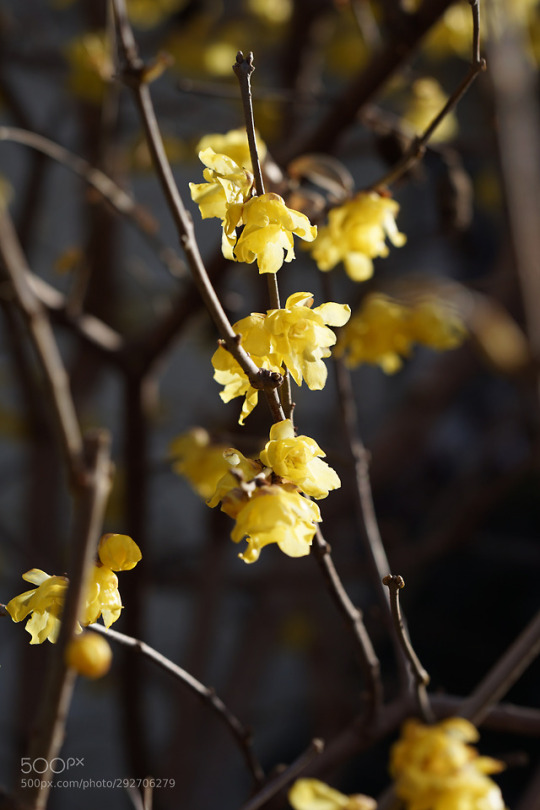
Fourcolor Macro: Winter color. by sinakamuraaurora
0 notes